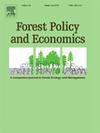The cointegration of Polish timber sales channels: Patterns and implications
IF 3.8
2区 农林科学
Q1 ECONOMICS
引用次数: 0
Abstract
This study examines the cointegration of timber prices across key sales channels in the Polish timber market, with a focus on competitive dynamics and international integration. Poland’s State Forests National Forest Holding, managing 82% of the country’s forested areas and providing over 95% industrial timber, has a near-monopoly structure. Timber sales are facilitated through three main channels: PL-D, the e-Drewno System, and e-Drewno Individual Auctions. Using cointegration analysis, we assess the connection between these channels and European timber markets. Our findings show limited cointegration in the PL-D and e-Drewno System channels, suggesting they are insulated from international price fluctuations due to restricted access requirements based on purchase history. Conversely, e-Drewno Individual Auctions – open to all without entry restrictions – demonstrate substantial cointegration with other European markets, indicating a higher level of competitiveness and responsiveness to external price trends. In addition, aggregate prices across all channels exhibit moderate cointegration with international markets, reflecting both price stability and adaptation to broader market trends. These findings reveal structural limitations in the Polish timber market: established firms benefit from stable pricing in restricted channels, while new entrants face higher costs in the more volatile, open channels. Policy implications suggest the need for reforms to enhance market inclusivity and prepare for potential supply constraints under changing environmental and regulatory conditions. This research highlights the critical role of channel-specific structures in shaping market behavior and influencing international integration in the timber industry.
波兰木材销售渠道的协整:模式与启示
本研究考察了波兰木材市场主要销售渠道中木材价格的协整,重点是竞争动态和国际一体化。波兰国家森林国家森林控股公司管理着该国82%的森林面积,提供95%以上的工业木材,拥有近乎垄断的结构。木材销售通过三个主要渠道进行:PL-D、e-Drewno系统和e-Drewno个人拍卖。使用协整分析,我们评估了这些渠道与欧洲木材市场之间的联系。我们的研究结果表明,PL-D和e-Drewno系统渠道的协整有限,表明它们不受国际价格波动的影响,因为基于购买历史的限制访问要求。相反,e-Drewno个人拍卖-对所有人开放,没有进入限制-显示出与其他欧洲市场的实质性协一体化,表明更高水平的竞争力和对外部价格趋势的反应。此外,所有渠道的总价格与国际市场表现出适度的协整,反映了价格稳定性和对更广泛市场趋势的适应。这些发现揭示了波兰木材市场的结构性局限性:成熟企业在受限渠道中受益于稳定的定价,而新进入者在更不稳定的开放渠道中面临更高的成本。政策影响表明,需要进行改革,以增强市场包容性,并为不断变化的环境和监管条件下潜在的供应限制做好准备。本研究强调了渠道特定结构在塑造市场行为和影响木材行业国际一体化方面的关键作用。
本文章由计算机程序翻译,如有差异,请以英文原文为准。
求助全文
约1分钟内获得全文
求助全文
来源期刊

Forest Policy and Economics
农林科学-林学
CiteScore
9.00
自引率
7.50%
发文量
148
审稿时长
21.9 weeks
期刊介绍:
Forest Policy and Economics is a leading scientific journal that publishes peer-reviewed policy and economics research relating to forests, forested landscapes, forest-related industries, and other forest-relevant land uses. It also welcomes contributions from other social sciences and humanities perspectives that make clear theoretical, conceptual and methodological contributions to the existing state-of-the-art literature on forests and related land use systems. These disciplines include, but are not limited to, sociology, anthropology, human geography, history, jurisprudence, planning, development studies, and psychology research on forests. Forest Policy and Economics is global in scope and publishes multiple article types of high scientific standard. Acceptance for publication is subject to a double-blind peer-review process.
 求助内容:
求助内容: 应助结果提醒方式:
应助结果提醒方式:


